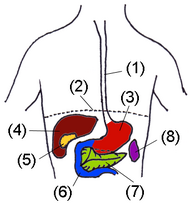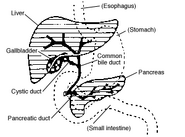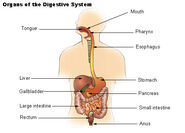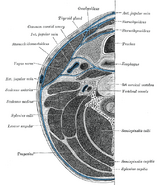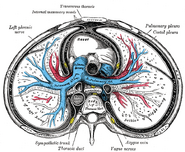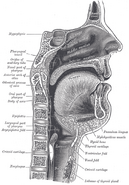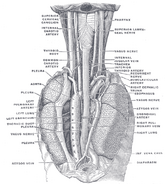No edit summary |
No edit summary |
||
| (One intermediate revision by the same user not shown) | |||
| Line 46: | Line 46: | ||
==See also== |
==See also== |
||
| − | * [[ |
+ | * [[Achalesia]] |
| + | * [[Esophageal]] |
||
| + | * [[Esophageal disorders]] |
||
| + | * [[Esophageal dysphagia]] |
||
==Additional images== |
==Additional images== |
||
Latest revision as of 08:26, 27 August 2012
Assessment |
Biopsychology |
Comparative |
Cognitive |
Developmental |
Language |
Individual differences |
Personality |
Philosophy |
Social |
Methods |
Statistics |
Clinical |
Educational |
Industrial |
Professional items |
World psychology |
Biological: Behavioural genetics · Evolutionary psychology · Neuroanatomy · Neurochemistry · Neuroendocrinology · Neuroscience · Psychoneuroimmunology · Physiological Psychology · Psychopharmacology (Index, Outline)
| Oesophagus | ||
|---|---|---|
| Head and neck. | ||
| Latin | Oesophagus(NECK) | |
| Gray's | subject #245 1144 | |
| System | ||
| MeSH | A03.556.875.500 | |
| Digestive organs. (Esophagus is #1) | ||
The esophagus or oesophagus (see American and British English spelling differences), sometimes known as the gullet, is an organ in vertebrates which consists of a muscular tube through which food passes from the pharynx to the stomach. The word esophagus is derived from the Latin oesophagus, which derives from the Greek word oisophagos (οισοφάγος), lit. "what carries and eats". In humans the esophagus is continuous with the laryngeal part of the pharynx at the level of the C6 vertebra. The esophagus passes through a hole in the thoracic diaphragm called the esophageal hiatus at the level of the tenth thoracic vertebrae (T10). It is usually 25-30 cm long which connects the mouth to the stomach. It is divided into cervical, thoracic, and abdominal parts.
Functions of the esophagus
Food is passed through the esophagus by using the process of peristalsis. Specifically, it connects the pharynx, which is the body cavity that is common to the digestive factory and respiratory system with the stomach, where the second stage of digestion is initiated.
The esophagus is deeply lined with muscle that acts with peristaltic action to move swallowed food down to the stomach. Due to the fact that the esophagus lacks the mucus lining like that of the stomach, it can get irritated by stomach acid that passes the cardiac sphincter.
Histology
The layers of the esophagus are as follows:[1]
- mucosa
- nonkeratinized stratified squamous epithelium: is rapidly turned over, and serves a protective effect due to the high volume transit of food, saliva and mucus.
- lamina propria: sparse.
- muscularis mucosae: smooth muscle
- submucosa: Contains the mucous secreting glands (esophageal glands), and connective structures termed papillae.
- muscularis externa (or "muscularis propria"): composition varies in different parts of the esophagus, to correspond with the conscious control over swallowing in the upper portions and the autonomic control in the lower portions:
- upper third, or superior part: striated muscle
- middle third, smooth muscle and striated muscle,
- inferior third: predominantly smooth muscle.
- adventitia
Gastroesophageal junction
The junction between the esophagus and the stomach (the gastroesophageal junction or GE junction) is not actually considered a valve, although it is sometimes called the cardiac sphincter, cardia or cardias, but is actually more of a stricture.
See also
Additional images
References
External links
- REDIRECT Template:Digestive tract
| This page uses Creative Commons Licensed content from Wikipedia (view authors). |

